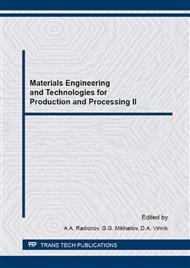p.578
p.584
p.593
p.598
p.603
p.608
p.614
p.620
p.625
The Study of the Strained State of the Long-Length Aluminum Billet Obtained by a New Method - Multi-ECAP-Conform
Abstract:
This paper presents the results of a computer and experimental study of a promising severe plastic deformation (SPD) technique, called Multi-ECAP-Conform (M-ECAP-C), for the fabrication of long-length nanostructured billets (wire rods) with an enhanced strength and electrical conductivity from the aluminum alloy EN-AW 6101 per one processing cycle. On the basis of the obtained results, a new rational geometry of the pressing channel for the M-ECAP-C process has been developed. The strained state of pilot samples of wire rods have been studied. Using the method of dividing grids shows the character of accumulation and the achieved level of deformation shear during the experimental treatment, and the average value of the shear deformation of the central region of the workpiece is 3.015. It was found that the error between the obtained values of the experimental method of grids, computer modeling and calculation is, respectively, 10 % and 17 %. The error between the experimental and computer modeling is not so important, so application of the computer modeling to estimate the strain state of the method of the Multi-ECAP-Conform is completely adequate.
Info:
Periodical:
Pages:
603-607
Citation:
Online since:
September 2016
Authors:
Price:
Сopyright:
© 2016 Trans Tech Publications Ltd. All Rights Reserved
Share:
Citation:


